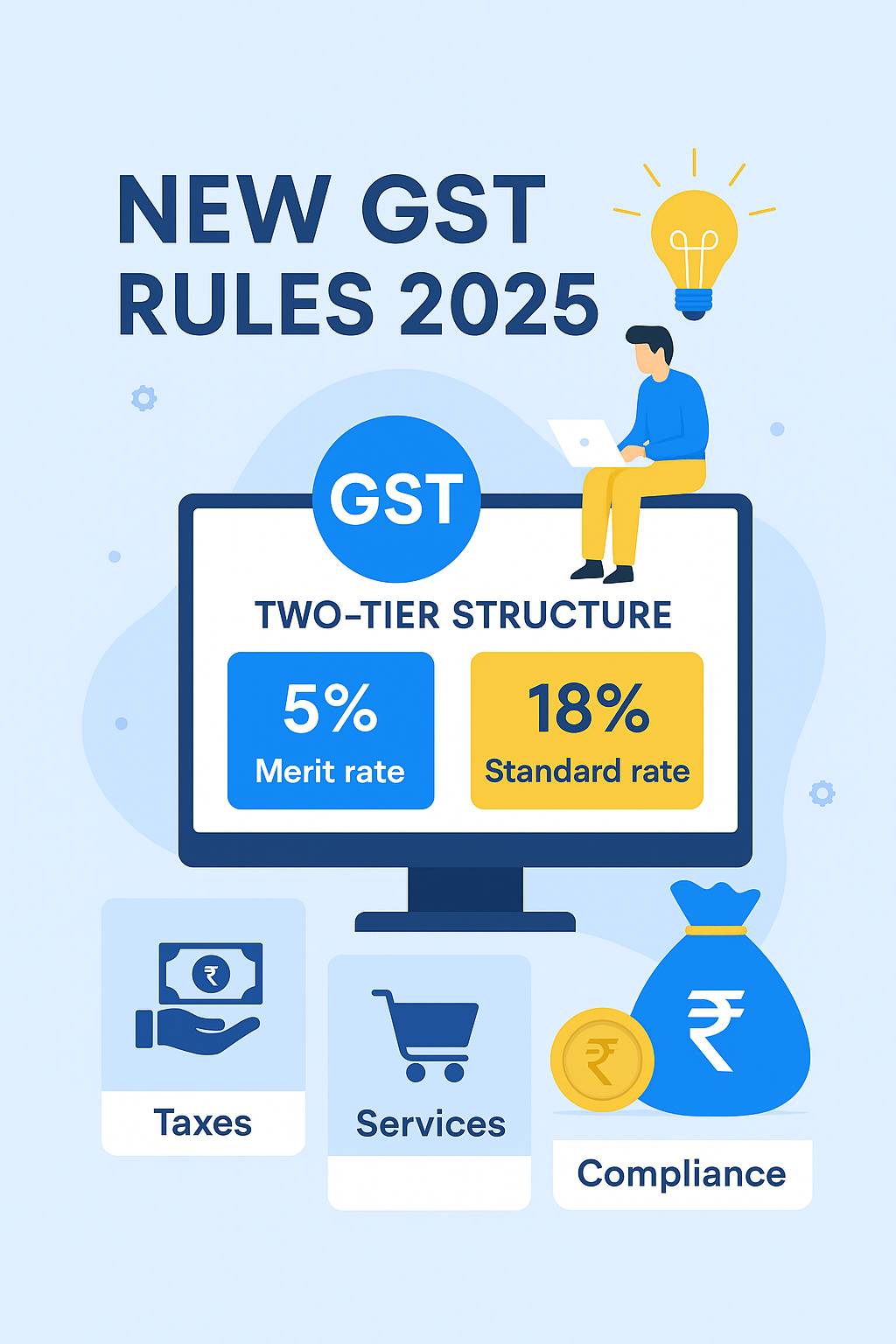The Goods and Services Tax (GST) has been a game-changer for India since its launch in July 2017. By replacing multiple indirect taxes with a unified structure, GST simplified compliance, reduced cascading taxes, and created a seamless national market.
In September 2025, the 56th GST Council meeting introduced major changes to GST rates and compliance rules, which will take effect from 22nd September 2025, as per the CBIC notification. These updates are designed to ease compliance, lower costs for businesses, and ensure fair taxation. Here’s a complete breakdown of the new GST rates, slab changes, and sector impacts.
What Are the GST Rate Slabs in India (Updated Sep 2025)
According to the latest GST changes, the new GST regime is structured across two primary slabs 5% and 18% with a special rate 40% (sin tax), depending on the nature and necessity of goods and services. Essential items are taxed at lower rates to ensure affordability, while luxury and sin goods are taxed at higher rates to regulate consumption and generate revenue.
This structured approach ensures that essential goods remain accessible while luxury services and products contribute appropriately to the government's tax base.

Latest GST Updates for the FY 25-26: 56th GST Council Meeting Highlights (4th September 2025)
The 56th GST Council meeting held on 4th September 2025 introduced several significant updates to the Goods and Services Tax (GST) framework for FY 2025-26. These changes, effective from 22nd September, are aimed at further streamlining compliance, enhancing taxpayer relief, and strengthening governance within the tax administration.
New GST rates
Check out the table given below to get a concise overview of the GST rate slabs and examples of goods and services under each category.
| GST Rate |
Examples of Goods and Services |
|
|
0% |
|
|
|
5% |
|
|
|
18% |
|
|
|
40% |
|
|
|
Special Rates |
|
|
Understanding these rates helps businesses comply with tax regulations and allows consumers to be aware of the taxes they are paying on goods and services. As GST continues to evolve, staying informed about the current rates and slabs is crucial for everyone involved in the Indian economy.
What gets cheaper?
Good news! The updated GST rates are here, and they’re making everyday essentials more affordable:
- Food & Beverages: Love butter, ghee, dry fruits, jams, fruit juices, or ice cream? You’re in luck! The GST on these items has dropped from 18% to just 5%.
- Household Basics: Shampoo, soap, toothpaste, toothbrushes, face powder, and hair oil are now easier on the wallet with GST reduced from 18% to 5%.
- Healthcare: Life-saving drugs, thermometers, diagnostic kits, and even corrective spectacles are now either taxed at 5% or completely exempt. Health just got a little more affordable!
- Consumer Electronics: Big-ticket items like air conditioners, dishwashers, and TVs now come with a lower GST of 18%, down from the hefty 28%.
- Stationery: School and office supplies like maps, charts, globes, pencils, crayons, and notebooks are now GST-free! That’s a big drop from the earlier 12%.
- Footwear & Textiles: From shoes to clothes, these essentials now have a GST rate of 5%, down from 12%. Shopping just got more fun!
What gets costlier?
While many essentials are getting cheaper, some luxury and "sin" goods are seeing a tax hike:
- Tobacco Products: Cigarettes, chewing tobacco, and pan masala will now face a steep 40% GST, up from the earlier 28%.
- Aerated Beverages: Love your fizzy drinks? They’ll now come with a 40% GST tag.
- Luxury Cars: High-end vehicles are also moving into the 40% tax bracket, making them even more exclusive.
- Online Gaming: Activities like betting, gambling, and online money gaming will now attract a hefty 40% GST.
These changes aim to balance affordability for essentials while discouraging indulgence in luxury and "sin" goods.
How Will the 2025 GST Update Impact Different Sectors?
The recent amendments introduced by the GST Council from 22nd September 2025 aim to simplify compliance, reduce costs, and boost economic activities across sectors. Below is an analysis of how these updates are expected to impact businesses, consumers, and industry sectors:
MSMEs, Startups, and Small Businesses
- Simplified filing procedures like GSTR-1A for amendments and GSTR-9/9A exemptions for smaller taxpayers help reduce paperwork.
- Lowered TCS rate and easier reporting thresholds enhance cash flow and ease interstate trade.
- Faster refunds and waivers on penalties allow businesses to manage working capital better, helping growth and expansion.
Healthcare Sector
- Essential healthcare services remain exempt from GST, ensuring treatments and surgeries remain affordable.
- Cosmetic and appearance-enhancing procedures, however, are taxed at applicable rates, supporting fair competition.
- The exemptions encourage investments in healthcare infrastructure while maintaining access to basic medical services.
Real Estate Sector
- Affordable housing remains taxed at 1%, while non-affordable housing is at 5%, facilitating the government’s housing mission.
- Construction materials continue to be taxed in the 5%–28% range, affecting costs but promoting transparency.
- Developers benefit from streamlined compliance, while buyers gain clearer pricing structures.
Automobile Sector
- Luxury vehicles continue to attract higher tax rates, while electric and clean-energy vehicles benefit from concessions.
- Uniform taxation promotes fair competition across fuel types and encourages environmentally friendly investments.
- The sector aligns with sustainability goals while offering consumer-friendly options.
Hospitality and Tourism
- Hotels and restaurants are taxed based on tariff and service type—ensuring premium services contribute more to government revenue.
- Simplified GST returns and faster refunds encourage more domestic and international tourism investment.
Entertainment, Leisure, and Luxury Services
- High-end entertainment and luxury services face steeper tax rates, aligning with the principle of taxing non-essential consumption more heavily.
- These provisions support government revenue while incentivizing responsible spending.
Why Staying Updated on GST Matters
The 2025 GST updates bring both cost reductions for essentials and higher taxes on luxury consumption. For businesses, this means adjusting pricing, updating compliance processes, and re-evaluating tax strategies.
Consider TallyPrime, a robust software solution designed to seamlessly integrate GST calculations, invoicing, and compliance management. With TallyPrime, empower your business to navigate the complexities of GST effortlessly, allowing you to focus on what truly matters—growing your enterprise in the dynamic Indian market landscape. Embrace the future of taxation with TallyPrime and embark on a journey towards simplified business operations and accelerated growth.
Frequently Asked Questions (FAQs)
What are the different types of GST in India?
India implements four types of GST:
- SGST (State Goods and Services Tax)
- CGST (Central Goods and Services Tax)
- IGST (Integrated Goods and Services Tax)
- UGST (Union Territory Goods and Services Tax)
Who decides GST Rates in India?
GST rates and related provisions are determined by the GST Council, comprising 33 members including state Finance Ministers. Chaired by the Union Finance Minister, the GST Council meets to deliberate and decide on GST rates.
What are the GST rates in India?
GST rates in India are structured into two slabs 5% and 18% with special sin tax of 40%, applicable to various goods and services based on their categorization.
What is the GST exemption limit?
Under the GST regime in India, businesses with annual revenue below certain thresholds are exempt from mandatory GST registration. The exemption limit is set at ₹40 lakhs for businesses dealing in goods and ₹20 lakhs for those providing services. Businesses earning less than these amounts are not required to register for GST, although they can choose to register voluntarily.
How does the new GST impact real estate sector?
- Affordable housing taxed at 1%, non-affordable at 5%.
- Construction materials taxed at 5–28%, ensuring transparency.
- Buyers benefit from clearer pricing structures.
Tool
Read More on GST Rates & Charges
GST Rate Finder, GST Rate on Labour Charges, HSN Codes, SAC Codes, GST State Codes
GST
GST Software, GST Calculator, GST on Freight, GST on Ecommerce, GST Impact on TCS, GST Impact on TDS, GST Exempted Goods & Services, Reverse Charge Mechanism in GST, GST Declaration, GST Compliance, GST Record Keeping
Types of GST
CGST, SGST, IGST, UTGST, Difference between CGST, SGST & IGST
GST Returns
GST Returns, Types of GST Returns, New GST Returns & Forms, Sahaj GST Returns, Sugam GST Returns, GSTR 1, GSTR 2, GSTR 3B, GSTR 4, GSTR 5, GSTR 5A, GSTR 6, GSTR 7, GSTR 8, GSTR 9, GSTR 10, GSTR 11











